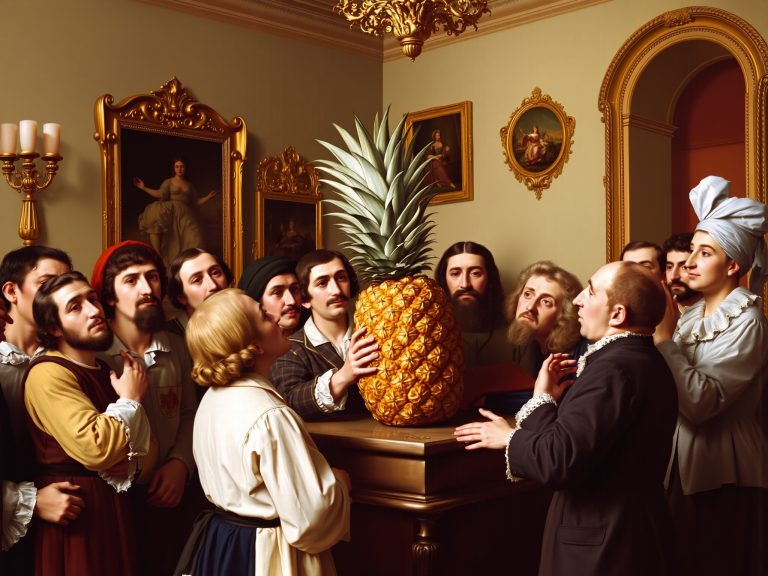In a remarkable twist of history, recent findings have unveiled that the Tudors, renowned for their opulent feasts and grandiose events, also pioneered a unique form of celebration: underwater banquets. This astonishing revelation sheds new light on the technological advancements and lavish lifestyles of the Tudor era.
Historians and archaeologists have long marveled at the Tudors’ penchant for extravagance, but the discovery of underwater banquet sites off the coast of England has sparked a wave of excitement and intrigue. The centerpiece of these aquatic feasts was the use of early diving bell technology, allowing guests to dine beneath the waves in an unprecedented display of ingenuity and luxury.
The diving bells, constructed from wood and reinforced with metal, were large enough to accommodate small groups of diners. To enhance the underwater experience, these bells were equipped with windows made from a specially treated, transparent material akin to modern-day glass. This allowed diners to view the marine life swimming around them, creating a mesmerizing dining environment. Air was supplied through long tubes connected to the surface, enabling attendees to breathe comfortably while enjoying their meals. These underwater chambers were lavishly decorated, mirroring the opulence of the Tudor court with rich tapestries, gold-plated utensils, and crystal goblets.
The menus for these banquets featured an array of seafood delicacies, freshly caught and prepared to the highest standards of Tudor cuisine. Dishes included oysters, lobster, and a variety of fish, all complemented by exotic fruits and imported wines.
This newfound knowledge not only highlights the Tudors’ flair for grandeur but also their pioneering spirit in the realm of technology. The underwater banquets of the Tudor era stand as a testament to human ingenuity and the ceaseless pursuit of wonder and innovation in the most unexpected of places.
Actual knowledge about the theme
Fascinating Facts About the Tudor Era
-
The Tudor Dynasty’s Origin
- The Tudor dynasty began with Henry VII’s victory at the Battle of Bosworth in 1485, ending the Wars of the Roses and establishing a new era of English monarchy.
- More about Henry VII
-
Henry VIII’s Six Wives
- Henry VIII is famously known for his six marriages, which significantly impacted English politics and religion. His wives were Catherine of Aragon, Anne Boleyn, Jane Seymour, Anne of Cleves, Catherine Howard, and Catherine Parr.
- Details on Henry VIII’s marriages
-
The English Reformation
- The English Reformation began in the 1530s when Henry VIII broke away from the Roman Catholic Church, leading to the establishment of the Church of England.
- Learn about the English Reformation
-
Elizabeth I’s Golden Age
- Elizabeth I’s reign (1558-1603) is often referred to as the Golden Age of England, marked by flourishing arts, exploration, and the defeat of the Spanish Armada in 1588.
- More on Elizabeth I’s reign
-
Tudor Architecture
- Tudor architecture is characterized by timber-framed buildings, steeply pitched gable roofs, and large chimneys. Notable examples include Hampton Court Palace and many rural cottages.
- Tudor architecture
-
The Mary Rose
- The Mary Rose was a warship in Henry VIII’s navy that sank in 1545. It was rediscovered and raised in 1982, offering invaluable insights into Tudor maritime life.
- The Mary Rose
These facts provide a glimpse into the rich and complex history of the Tudor era, a period marked by significant social, political, and cultural transformations.
Five Key Facts About Diving Bells
-
Historical Origins
- The concept of the diving bell dates back to ancient times, with the earliest known descriptions appearing in the works of Aristotle in the 4th century BCE. These early diving bells were primitive, often simple inverted vessels used to trap air and allow short durations of underwater work.
- More about ancient diving bells
-
Medieval and Renaissance Advances
- During the Renaissance, the development of diving bells saw significant advancements. In the 16th century, the famous polymath Leonardo da Vinci sketched designs for more sophisticated diving apparatus. The first practical diving bell that allowed more extended underwater exploration was developed in the 16th century by Guglielmo de Lorena, who used it for underwater archaeological work.
- Medieval diving bell designs
-
Basic Design and Operation
- A diving bell is essentially a rigid chamber open at the bottom and lowered into the water, trapping a pocket of air inside. The pressure of the water keeps the air in place, allowing divers to breathe and perform tasks underwater. Early diving bells were often lowered from ships using ropes or chains and required a supply of fresh air, initially from the surface.
- Basic principles of diving bells
-
Modern Enhancements
- In the 17th and 18th centuries, improvements in materials and engineering led to more effective and safer diving bells. The introduction of air pumps allowed for a continuous supply of fresh air, enabling divers to stay submerged longer and work more efficiently. These advancements paved the way for the use of diving bells in salvage operations, underwater construction, and scientific research.
- Advancements in diving bell technology
-
Diving Bells Today
- Modern diving bells are highly advanced and are often used in conjunction with other diving equipment like submersibles and saturation diving systems. They are essential tools in underwater construction, repair of underwater pipelines, and deep-sea exploration. These contemporary bells are designed with safety and efficiency in mind, incorporating advanced materials, air supply systems, and communication devices to support divers working at great depths.
- Modern use of diving bells





